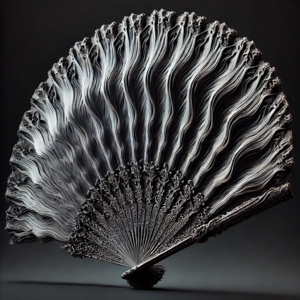
Murmurfang’s ribs are forged from Heavy Iron, an impossibly dense, dark metal that feels far heavier than its size suggests. It is cold to the touch yet resists all heat, refusing to glow even in the hottest forge. The fan itself is crafted from Demon-Steel, a substance said to be woven from liquid metal tempered in unnatural flames. Its surface shifts subtly, patterns twisting like smoke trapped beneath glass, making it difficult to tell exactly where its edges lie.
Powers
- Coldbrand Embers – Strikes leave behind lingering, cold fire that does not burn flesh but numbs and slows movement, as if freezing the affected area from the inside. The flames flicker unnaturally, casting shadows where there should be none.
- Phantom Veil – The wielder can momentarily erase themselves from awareness. Not true invisibility—observers simply fail to notice them until they act again. Cameras and recordings still reveal their presence.
- Echo of Presence – The wielder can leave behind a fleeting afterimage—a sensory mirage that looks, sounds, and even feels real for a second. The more the fan is used, the more unintentional echoes linger.
- Veilshatter – With a precise flick, Murmurfang can disrupt incoming spells, causing them to fracture midair like shattered glass. The fragments of magic briefly hang in place, twisting unpredictably before fading—sometimes warping into brief, harmless illusions.
Drawbacks
- Unreliable Reflection – Mirrors and recordings do not fully align with the wielder. Their reflection lags behind, moves out of sync, or stares back too intently. At first, it is subtle—a trick of the light, a fleeting mistake—but over time, others begin to notice before the wielder does.
- Veil Fractures – Frequent use of Murmurfang to disrupt magic causes small distortions in reality around the wielder. Colors subtly shift, objects feel slightly misplaced, and sounds fluctuate between too sharp or eerily muffled. Overuse deepens the fractures, leading to moments of disorientation where the world feels wrong, as if the wielder has stepped into a slightly altered version of their own reality.
- Gnawing Whispers – The fan never falls silent. At first, the whispers are distant, easily dismissed as wind through the ribs—but as Murmurfang is used, they grow clearer and more personal, speaking in the wielder’s own voice, saying things they do not remember thinking. Ignoring them requires effort, but the strain creates a growing sense of dissonance—attacks land a fraction too late, movements feel sluggish, and the whispers begin finishing the wielder’s sentences before they do.
The History of Murmurfang
Forged in Sengoku-era Japan by the elusive metalsmith Uryū Hanza, Murmurfang was crafted for Lady Tokisada, the Phantom of Kai, a strategist who wielded deception as a weapon. Its Heavy Iron ribs came from a fallen star near Mount Osore, while its Demon-Steel fan was woven from liquid metal in the vanished village of Kamiyama. A weapon of illusions and unseen strikes, it granted its wielder mastery over perception—until Tokisada herself began slipping from reality. Her movements faltered, her reflection no longer hers, and in 1573, she vanished entirely, leaving Murmurfang behind, whispering. It was sealed away in Tendai-ji, a remote temple, where monks warned it should never be opened again.
In 1868, foreign smugglers stole Murmurfang during the collapse of the Tokugawa shogunate, selling it to Sir Edgar Wakefield in England, who was found dead years later, his journal filled with a single, repeating phrase: "I am not." Passed through occult circles, it surfaced in 1923 New Orleans, where stage magician Mathilda Graves wielded it to eerie effect before falling into madness. Since then, it has reappeared in whispers—linked to vanished thieves, untraceable assassins, and those who seem to step outside reality itself. Each wielder seeks mastery over the intangible, yet all succumb to the same fate: fading, piece by piece, until they are nothing more than an echo in the steel.